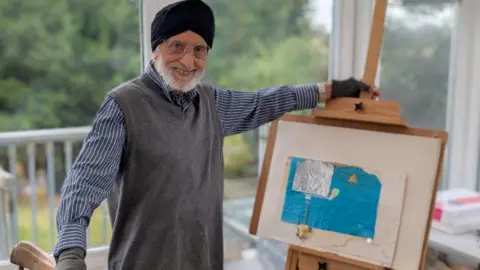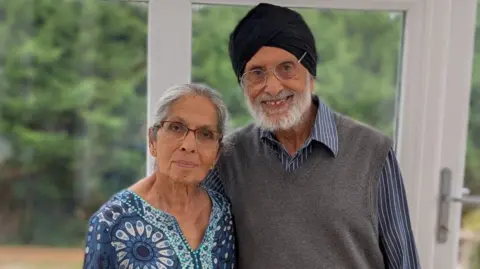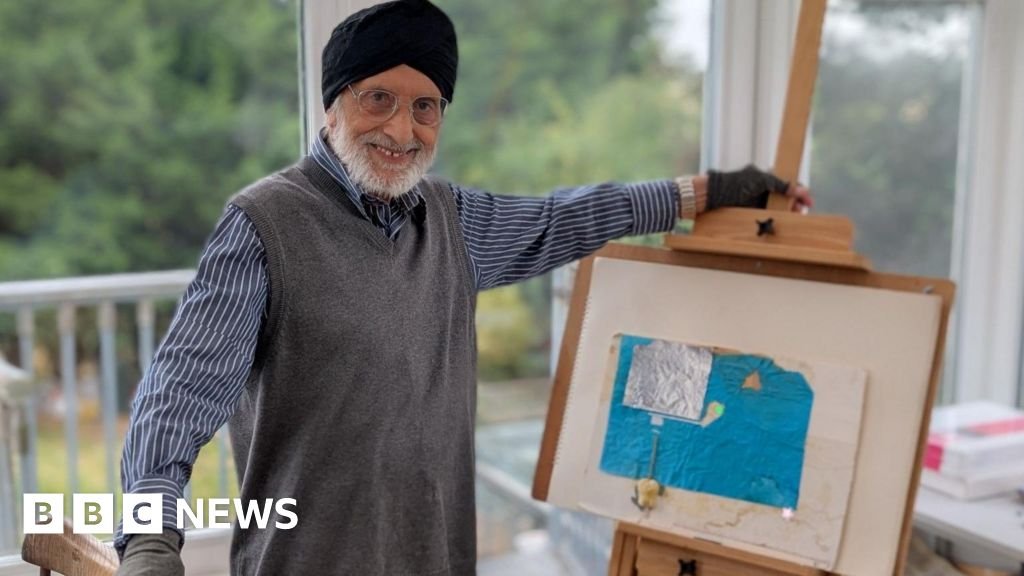BBC News, Nottingham
 BBC
BBC“I don’t plan my work completely. It comes together. Like life.”
Sardul Gill has been developing his artistic style over decades during which he moved from India, to Kenya and then to Nottingham, where he taught for nearly 30 years.
The 87-year-old regularly uses ‘found’ items to create collages, alongside prints and paintings which often have a religious or spiritual theme.
He has now received national recognition after he was featured in a book on the history of British South Asian art, from Tate Publishing.

Mr Gill was born in India but moved to Kenya following the death of his father.
He took a job working at a garage in Kenya, where he won first prize at an exhibition with a painting called Sita in 1959.
“Someone [offered] me a thousand shillings for it,” he said. “But I couldn’t sell it. It was the beginning of everything.”
Mr Gill then came to the UK in 1963 and finally settled in Nottingham in 1972, where he studied diplomas in Art and Education, gained an MA in Fine Art and taught as a lecturer at what was then South Nottingham College for almost 30 years.
Mr Gill added: “Whenever I am going through Nottingham, ex-students come up to me and say how I motivated them.”
“I showed them my own work in the college so that students could see what I was doing, not just what I was teaching.”
Beginning with landscape and realism, Mr Gill later turned toward abstraction, collage, and installation.
One ever-present in his work is recycled material — polystyrene, cardboard, even scrap palettes.
“Recycling is the right word,” he said. “I use what I find. Nothing is wasted.”

Mr Gill said his work frequently deals with cultural remembrance.
He painted a portrait of Guru Nanak for his mother, shortly before she died.
“She wouldn’t have gotten abstraction,” he said. “So I painted something she could really relate to.”
His wife, Inderjit Gill, said: “When he’s painting, he doesn’t think about anything else — even his tea.
“He’s in a meditative state.”
Mrs Gill has played a key role in his career and handled communications, organised exhibitions and ensured Mr Gill was able to focus on creating art.
“I like living in an art gallery,” she smiles. “I say to him — let’s put more work up.”
He was a prominent figure in Nottingham’s Asian Artists Group during the 1980s and had his work exhibited widely, from Leicester Museum to the New Art Exchange.
Now, his piece, Earth Shrine, will appear in Alina Khakoo’s ‘A Brief History of British South Asian Art’, from Tate Publishing.
The painting, composed of texture, nature forms, and metaphorical items is presented as a reflection of Gill’s compound, intuitive style.
“I don’t plan my work completely,” he said. “It comes together. Like life.”
Mr Gill said he was delighted to have his work acknowledged in the book.
“All artists want to be acknowledged,” he added. “This is gratifying. Surprising. An honour.”


